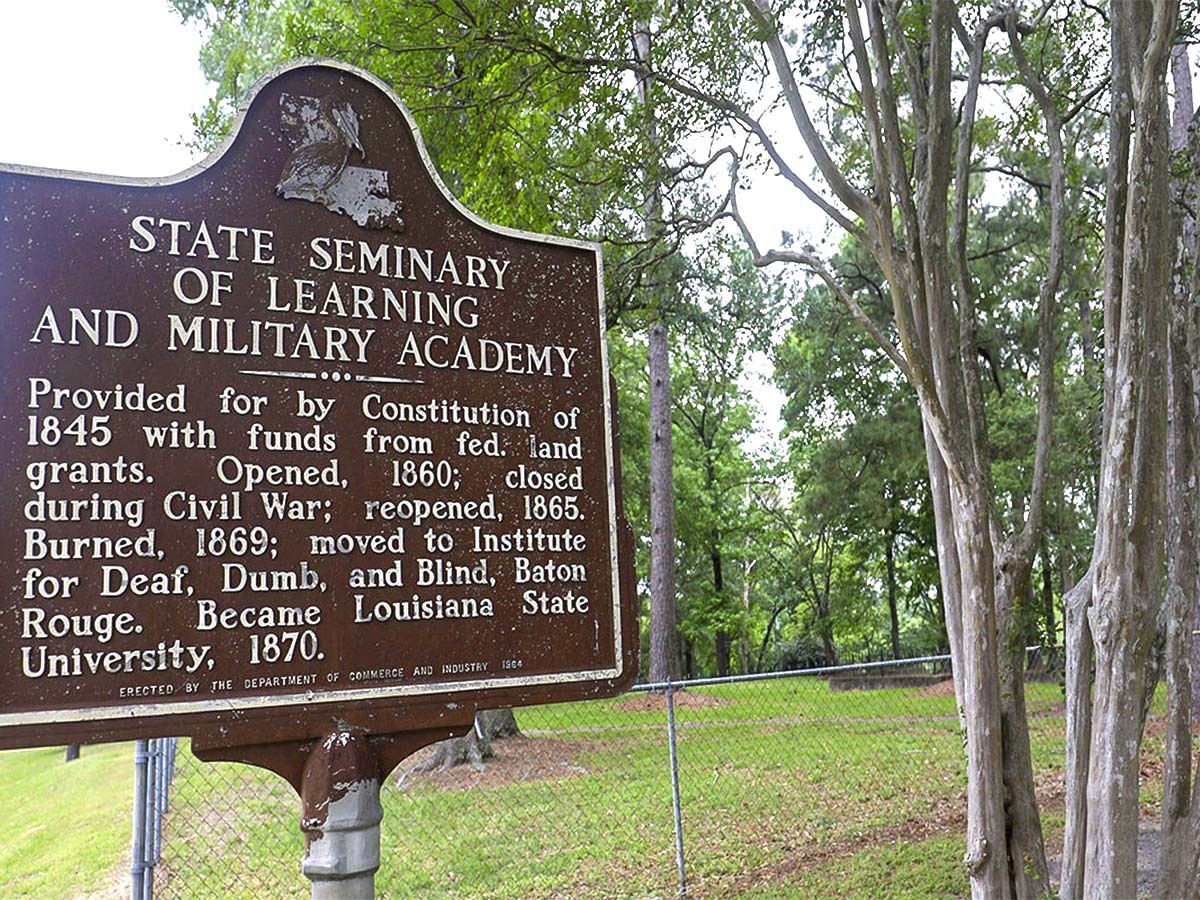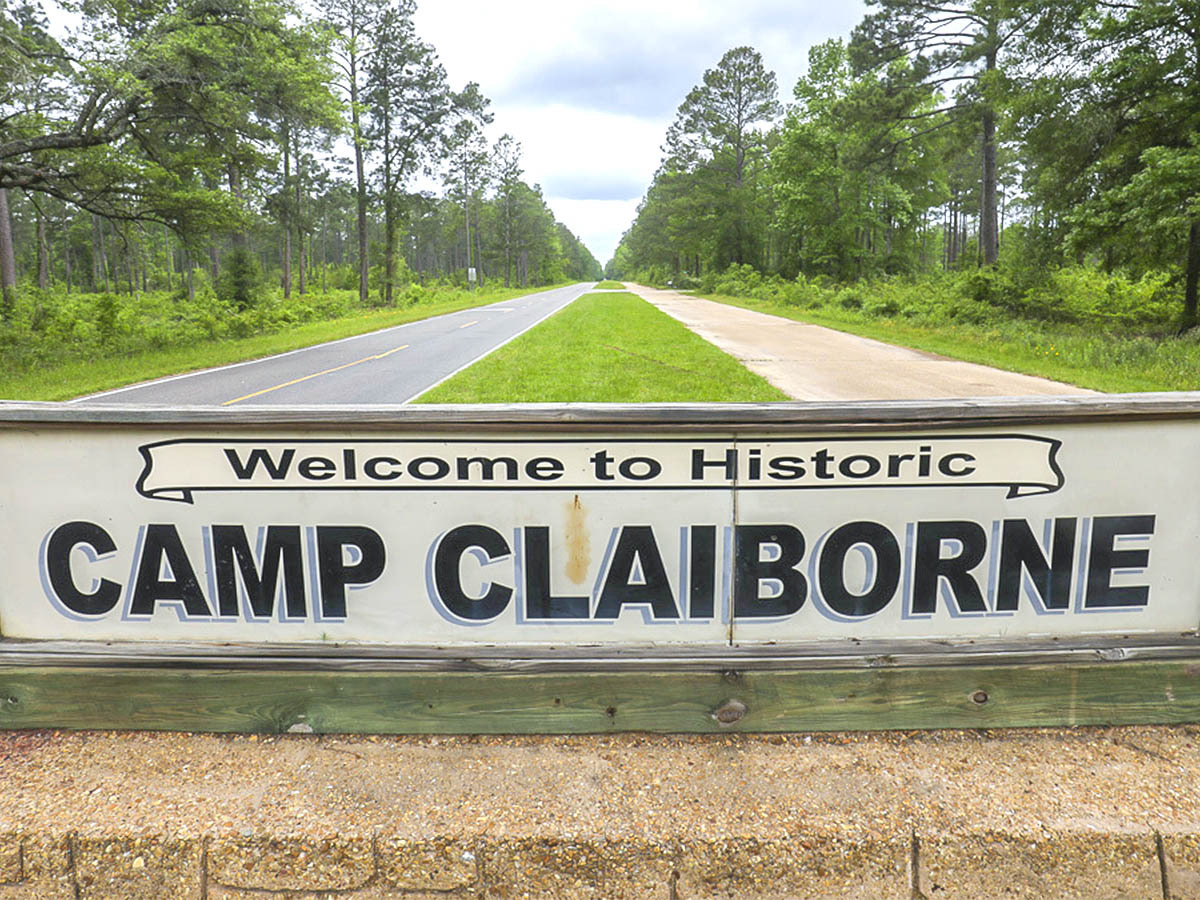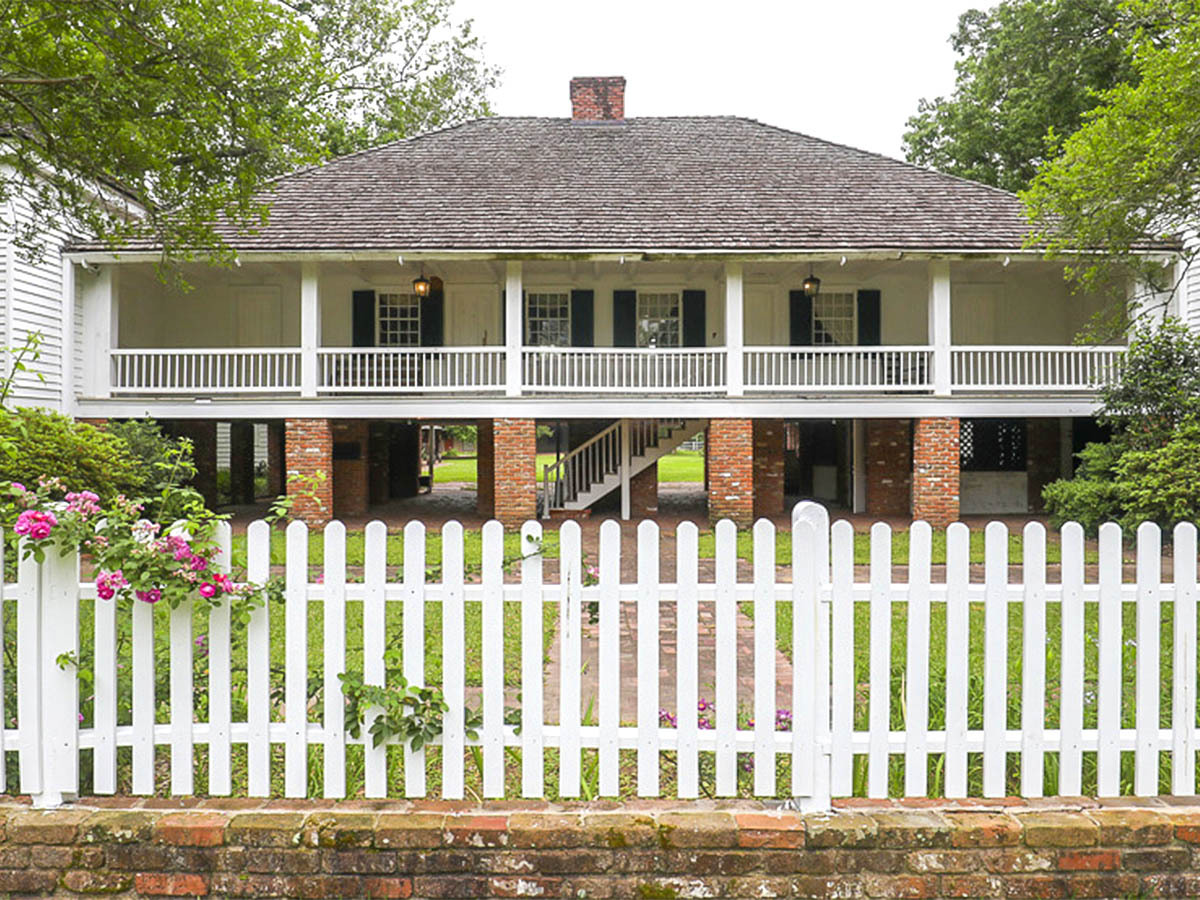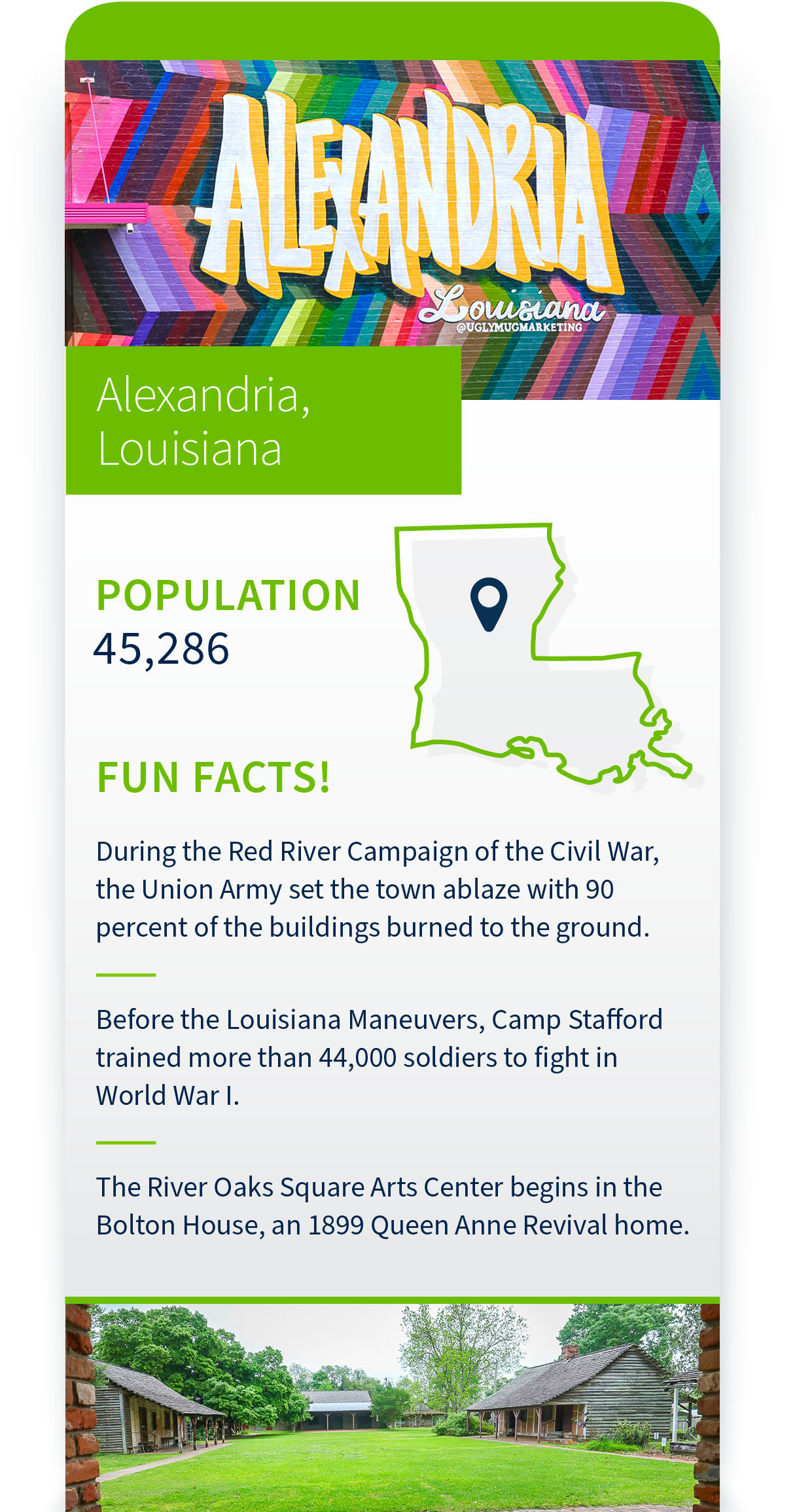Good Towns is a regular feature of Doing More Today, highlighting the people and places that make communities unique.
On the edge of the Kisatchie National Forest, next to the park service office and across the street from the sprawling VA facility, an unassuming marker denotes the birth of one of the nation’s best-known universities.
It was here, way back in 1859, the Louisiana Seminary and Military Academy first took flight as the state’s premier public college. A year later, students began streaming in under the direction of superintendent Col. William T. Sherman.
Welcome to the birthplace of a beloved institution now known as Louisiana State University, aka LSU.

A sign next to the National Parks office notes where the State Seminary of Learning and Military Academy was founded. That school became LSU. / GARY TRAMONTINA PHOTOS

One of the many ancient oak trees that line the campus of the VA Medical Center in Pineville.

Jet Airplanes are poised to protect the Alexandria International Airport.

A local strolls along the banks of the Red River in downtown Alexandria.

A popular coffee shop in downtown Alexandria helps the city center start the day.

The old downtown clock is considered an Alexandria landmark.

A patron enjoys a luscious meal on the back deck of Tunk's Cypress Inn, a popular eatery since the mid-1970s.

Large raw oysters on a platter - complete with lemon, cocktail sauce and horseradish - the perfect appetizer at Tunk's.

This mouthwatering meal is Tunk's Snapper Sandy, cooked and served in a paper bag.
The small campus in Pineville, a stone’s throw across the Red River from Alexandria, would be short-lived. After serving just 18 months, Sherman headed off to help lead Union troops in the Civil War, and his next trip South would be one of infamy. As for the little upstart college, it struggled in the next decade before a devastating fire forced the state to relocate LSU to its permanent home downstate in Baton Rouge.
Gone, but not forgotten, it’s a great launching point for our latest Good Town, Alexandria, Louisiana, where lofty ideas continue to impact the world we know.

A marker points to where Camp Claiborne stood prior to World War II. This became the home of Gen. Patton's elite tank troops. / GARY TRAMONTINA PHOTOS

In wilderness now used for hiking and biking a visitor can learn about the historic Louisiana Maneuvers.

Greek columns on the front exterior of Hotel Bentley enhance the establishment's reputation for quality.

The ornate lobby of Hotel Bentley features a stunning ceiling mural, plush couches and greenery throughout.

A wing of the Hotel Bentley serves as a museum for the famous Louisiana Maneuvers, holding photos, memorabilia and artifacts from the era.
Prelude to Victory
The world was ablaze in 1940. A generation after the war to end all wars, Europe was falling under the blitzkrieg of the German Army. Across the Atlantic, the U.S. remained a neutral observer, knowing full well that it must be ready if called.
By August 1941, America assembled the best of the best in Central Louisiana for a series of large-scale military exercises called the Louisiana Maneuvers, based out of Camp Livingston and Camp Claiborne, the latter located south of Alexandria. The Blue Army, consisting of close to 200,000 troops from Alabama, Arkansas, Louisiana, Mississippi and Tennessee emerged victorious under the leadership of Gen. George Patton.
The Louisiana Maneuvers brought together the 761st Tank Battalion, originally based at Camp Claiborne, and the 101st Airborne, made famous in the miniseries “Band of Brothers,” two outfits that would be the key to victory in World War II. Because of the size of the war exercises, many of the troops were housed with local citizens, who welcomed them with open arms.
In just a brief time, the Louisiana Maneuvers proved this force was ready for the fight. And by December, the U.S. could no longer call itself neutral after the attack on Pearl Harbor.
A bustling army base 80 years ago, Camp Claiborne has few reminders of its importance in world events. It’s now another part of the sprawling national forest and has become a haven for hikers and cyclists. But its history remains a source of pride.
That legacy is still honored at the historic Hotel Bentley in downtown Alexandria. With an ornate lobby, a water fountain and incredible chandeliers, the upscale facility made its debut in 1908 and has been lovingly restored with modern amenities that blend perfectly with the old-world charm.
In a corner of the first floor, a wing honors the Louisiana Maneuvers’ place in Alexandria lore. And the Hotel Bentley played a role. It’s there a trio of American leaders – Patton and Gen. Dwight Eisenhower and Gen. Omar Bradley – stayed in preparation for the war games.
And before heading off to Europe to save the day.

Leah Morace talks about her art and inspiration inside her studio at River Oaks Arts Center. / GARY TRAMONTINA PHOTOS

In a quiet studio at River Oaks Art Center, an artist can be seen patiently bringing new work to life.

Artist Randy Brodnax leads an attentive class at a pottery workshop at River Oaks Art Center.

A winged sculpture greets visitors at the entrance of River Oaks Arts Center.

Two patrons take in the latest exhibition at the Alexandria Museum of Art, a fixture in the region for 40-plus years.
Alexandria’s Incubator for Art
A few blocks downtown at the River Oaks Arts Center, Central Louisiana’s most renowned artist, Leah Morace, works in a studio creating her latest painting.
She’s affectionately known as “The Bird Lady” for her iconic photos of Louisiana-based pelicans and egrets. But her real talent is capturing the beauty of the state’s wildlife and waterscapes on canvas in realistic, lively color.
“My dad grew up on the bayou and I’d spend my summer on a boat with him,” Morace said, detailing the birth of her passion. “He was a bird watcher and he’d bring in friends from California who had never seen an eagle or an egret before.”
A graduate of nearby Louisiana College, she works out of a light-filled studio at River Oaks, alongside other artists from the region, while her children are in school.
“I can come here and be creative,” Morace said, “where I have great lighting and great traffic to draw in people and make sales. I love it here because of the collaboration with other artists.”
Taking it all in from the door, Rachael Dauzat smiles at seeing Morace’s latest work come to life.
As the executive director of River Oaks, she’s tasked with ensuring the future of Alexandria’s arts scene for years to come. That’s not only the visual medium, but live theatre across the street at the Coughlin Saunders Performing Arts Center, which routinely fills its 600-seat arena.
“Honestly, to have a facility this size and magnitude is incredible, because we don’t have a huge corporate base,” Dauzat said. “But what we do have is a very strong team, a dedicated board and a talented arts community. And we have a great relationship with the city, which pays for major maintenance costs.”
Downstairs, her assistant, Aubrey Bolen, is preparing for the 11th Annual Dirty South Cup Competition, with walls lined with vibrant, hand-painted coffee mugs. But Bolen pauses his day to show us a pottery workshop, led by artist Randy Brodnax, as he teaches the craft to an eager audience.
“We have 30 artists in residence,” Bolen explained. “We think of it as an incubator where we grow our own artists.”
If River Oaks is the birthplace, the Alexandria Museum of Art is where local, regional and international artists display their finished work. It opened in 1977 as an organ of the Central Louisiana Art Association, which precedes the Louisiana Maneuvers by three years. The current building opened in 1998, and it offers multiple levels to bemuse and wow.

Eric Lord, Regions' market leader for Alexandria, greets our team outside the bank's local headquarters. / GARY TRAMONTINA PHOTOS

Fish biologist Talon Jeppson talks about the process of building a bigger largemouth bass.

Talon Jeppson walks among rows of troughs filled with eggs and fry of largemouth bass in various stages of early development.

Recently fertilized eggs cover a mat that is used as an artificial nest at the hatchery.

A growing largemouth bass at the Booker Fowler Fish Hatchery.
A Win-Win for Everyone
A graduate of Louisiana Tech and a native of Tallulah on the Louisiana-Mississippi line, Eric Lord serves Regions Bank as the market leader for Alexandria. His expertise is growing businesses, especially on the agricultural side that dominates the region’s economy.
He now calls Alexandria home. As so do others for reasons both logical and logistical.
“We are two hours from everywhere,” Lord said.
That’s one of the reasons that lured Talon Jeppson to Central Louisiana. A Utah native with a master’s degree from Clemson, he once trailed moose across the Canadian wilderness before homing in on a career as a fish biologist at the Booker Fowler Fish Hatchery just south of Alexandria.
Now he’s an integral part of an new program to enhance the state’s fishing industry.
“We’re trying to create the biggest largemouth bass we possibly can,” Jeppson explained. “We’re trying to introduce the Florida strain of genetics into Louisiana body of water. Think of it this way: a good Northern bass grows to over 10 pounds, and that’s impressive. But a good Florida bass gets to over 22.”
The state record for largemouth bass is just under 16 pounds. By introducing the Florida strain and patiently mixing with local stock in the sprawling hatchery, Jeppson’s team can enhance what already is a lucrative fishing industry.
“We want that sports fish that breaks records,” Jeppson said. “It’s a win-win for anglers and environmentalists like us.”

A white picket fence surrounds the front yard of the famous Kent House. / GARY TRAMONTINA PHOTOS

LeAnne Raines on the front portico of the Kent House. The exterior is painted pearl white and the shutters are green.

LeAnne Raines shows how the 19th-Century overhead fan works in the original dining room of the Kent House.

LeAnne Raines gives a reporter the background of the Kent House's documents room.

A hand shows off fingerprints in the brick foundation of the Kent House. Bricks were made onsite during construction, and workers often began setting the masonry before it cooled.

This 350-year oak is one of Louisiana's oldest and guards the backyard at Kent House.
A Historic House, A Blending of Cultures
Built on a sizeable plot of land a tee shot from Bayou Rapides, which meanders a few miles before joining the Red River near Fort Buhlow, the majestic Kent House still draws tourists nearly 230 years after Pierre Ballio II decided to make his home here after receiving a land grant from Spain.
“It was the only home for 20 miles,” said LeAnne Raines, our historian and tour guide. “There were no roads, either. Back then, they depended on rivers and bayous for transportation.”
Now protected by a berm and surrounded by neighborhoods, the home remains elevated to survive the seasonal floods of its day, a time where the U.S. was in its infancy and the Louisiana Purchase had not yet fermented in Thomas Jefferson’s busy mind.
The original Kent House was built in the French-Creole style and featured only a handful of rooms and was insulated with bousilage, a mixture of red clay from the banks of the bayou, straw and animal hair to make it stick, that is still visible on the front porch.
When Robert Hynson took ownership a half-century later, he added a stunning office on one wing and a master suite on the other in the style of Greek Revival, which blended seamlessly while adding another layer of beauty. When the Union Army stormed through after the Civil War’s Battle of Mansfield, Hynson refused to abandon his home, and the Kent House was spared from fire.
Occupants of the home were also spared from the yellow fever outbreak of 1853, which saw Alexandria’s population drop from close to 1,000 inhabitants to about 150. And, in the 1960s, the Kent House survived another fate – the wrecking ball – when locals rose up to get it declared a historical treasure.
Today, the Kent House site includes other buildings of its era from a bygone plantation, including a cook house, barn, blacksmith shop and sugar mill, as well as a 350-year-old oak tree that stood a century before Pierre Ballio II arrived.
“We’re very unique here in that there’s such a diversity of cultures that have merged here since the state was founded,” Raines said. “To the north, Louisiana was settled by Protestants. From the south down, you have a mix of Cajun and Creole cultures that were predominately Catholic. Alexandria is where Louisiana comes together.”

Good Towns Archives
More From Alexandria